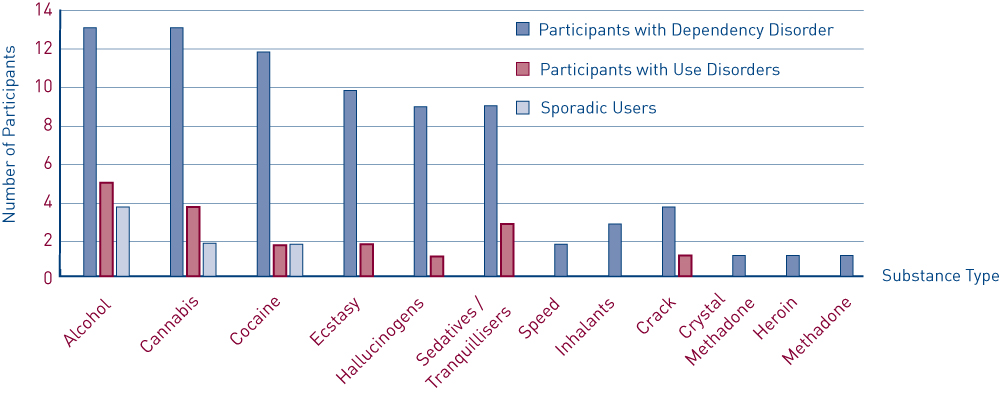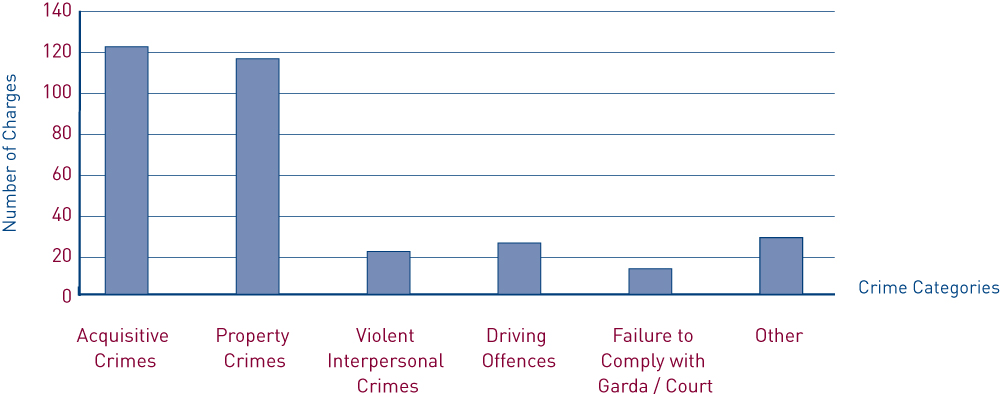Morgan, Angela and Long, Jean and Connolly, Johnny (2007) Mental illness and substance use among children in detention schools in Ireland. Drugnet Ireland, Issue 23, Autumn 2007, pp. 19-20.
| Preview | Title | Contact |
|---|---|---|
|
PDF (Drugnet Ireland, issue 23)
- Published Version
1MB |
Emotional intelligence, mental health and juvenile delinquency,1 the report of a study by Hayes and O’Reilly, was presented at an international conference at University College Dublin on 18 May 2007. Researchers interviewed three groups of adolescent males (average age 14.9 years): 30 participants were residing in juvenile detention schools (the offender group), 20 had been referred to an adolescent mental health service in HSE South (the mental health group), and 30 were recruited from a secondary school in County Cork (the control group). They used a number of validated instruments to determine each child’s emotional intelligence and mental well-being, and obtained demographic characteristics and history of offending by means of a questionnaire.
The findings show that children in detention schools in Ireland experience very high rates of substance dependence and psychiatric disorder, engage in serious criminal behaviour and have significant deficits in emotional intelligence and cognitive ability.
Eight out of ten (83%) of the offender group met diagnostic criteria for at least one psychological disorder, with the average being 3.1 disorders per detainee, which was considerably higher than that in the mental health group. Of the offender group, 18.5% reported experiencing thoughts of suicide, and the same percentage reported that they had attempted to take their lives on at least one occasion. Over one-third (38%) met diagnostic criteria for internalising (emotional) disorders such as anxiety and depression, and 68% for externalising (disruptive) disorders such as conduct and attention deficit disorders.
Sixty-seven per cent of the offender group met the criteria for at least one substance-related disorder. Approximately equal numbers reported using cocaine (13/30), alcohol (14/30) and cannabis (14/30). Based on participants’ reports of substance use in the 12 months prior to interview, researchers assigned them to one of three categories: dependency disorder (those addicted to one or more substances, n=14); use disorder (regular users of one or more drugs but who did not have a diagnosis of addiction, n=5); sporadic users (those who had used drugs in the past 12 months but not in sufficient quantities to warrant adiagnosis of dependency or use disorder, n=5) (Figure 1). One member of the offender group reported not having taken any drugs or alcohol in the previous 12 months.

Figure 1 Substances used by young offenders in the year prior to interview
Source: Hayes and O’Reilly (2007)
Detainees with substance dependency disorders reported that they first began to use alcohol and cannabis at an average age of just nine years, and cocaine at 13 years. The majority did not receive treatment for psychiatric or substance use problems. Despite incarceration, these boys had continued access to alcohol and drugs, possibly through home leave, during family visits or during court appearances. According to the authors, this continued access to drugs and alcohol served to sustain their dependency and use difficulties.
A total of 335 crimes were committed by the 30 young detainees. These offences included acquisitive crimes, property crimes, driving offences, violent interpersonal offences, and failure to comply with a Garda/court order. Figure 2 shows the number of charges within each crime category.

Figure 2 Number of criminal charges against respondents, by crime category
Source: Hayes and O’Reilly (2007)
The largest crime category was acquisitive crime, with 123 charges being held by 25 of the 30 participants. Although the majority of the participants had substance-related disorders, none was detained on an alcohol-related charge, and only one held a drug-related charge (possession of a controlled substance) The results also indicate high rates of recidivism, with over three-quarters (76.7%) of the sample having been detained on at least one other occasion.
The authors conclude that the level of criminality among youths in detention schools is very serious, with about one in three detainees charged with at least one offence relating to interpersonal violent crime. They state that the emotional intelligence deficits of the detainees may make it difficult for them to fully understand how their offending behaviour impacts on others, and that ‘a reduced capacity to regulate emotions could maintain offending patterns of behaviour in detainees’ (p. 55).
The authors highlight the importance of addressing mental health and substance use among children in detention schools. They believe that, in addition to reducing the debilitating effect of mental health problems on a child’s functioning and development, treatment will lead to a significant reduction in offending behaviour and criminality, with significant cost benefits for society, the legal system and the Irish State.
1. Hayes JM and O’Reilly G (2007) Emotional intelligence, mental health and juvenile delinquency. Cork: Juvenile Mental Health Matters.
G Health and disease > State of health
G Health and disease > State of health > Mental health
G Health and disease > Substance related disorder > Substance related mental health disorder
MM-MO Crime and law > Justice system > Correctional system and facility
T Demographic characteristics > Child / children
VA Geographic area > Europe > Ireland
Repository Staff Only: item control page